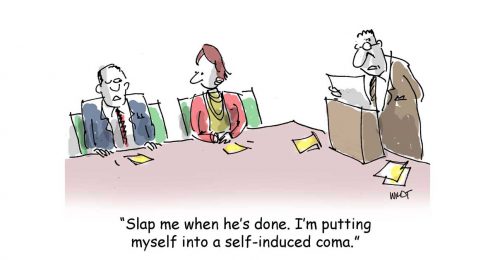A coaching client asked me to present at their board meeting some time ago. It’s not something I do very often and it had been a while.
Now many of you know I believe in the importance of building a real partnership between board and staff that fosters a thriving and sustainable nonprofit. I think many of you agree with this and work hard to bring that partnership to life.
Sometimes we don’t realize how we may be thwarting those efforts.
With the presentation in hand, I walk into the boardroom. It’s a lovely space with a big conference table with room for 24 folks. The board of 16 was settling in along with the Executive Director that left 7 empty seats.
Against the back wall around the table were chairs. Staff members attending the meeting walked in looking indecisive and a bit uncomfortable. With no guidance from the Executive Director who was schmoozing with board members, the 5 staff members passed by the open seats at the table and made their way to the back wall of chairs.
The kids’ table.
Many of us remember the kids’ table well. Family gatherings with a dining table too small for everyone. Decisions were made about who sat where. No grownup was ever assigned to the small card table with the folding chairs.
Right before my eyes, I saw the senior staff of a good-sized, mature nonprofit sitting at the kids’ table. I talked to staff during a break and debriefed with the Executive Director later. Staff members simply didn’t know their place. Literally and figuratively.
I knew this was not an anomaly. In fact, it is an excellent example of the organization’s copilots – the Executive director and Board Chair – falling down on the job.
It’s time for an adjustment.
THREE STEPS TO AVOID “KIDS’ TABLE SYNDROME”
1. DESIGN THE BOARD MEETING WITH YOUR CO-PILOT
Together, make intentional decisions about which staff should attend and the expectations that you have for each staff you plan to invite. Seems easy enough, right? Doesn’t happen often enough.
2. COMMUNICATE CLEARLY WITH KEY STAFF BEFORE THE MEETING
The Executive Director needs to be clear with the staff about who’s attending and why. This helps those not invited to understand without feeling slighted. For those attending, they will feel secure knowing their role. Key staff members have these questions whether they ask them or not.
Offering this clarity is the first step in creating a sense of belonging for staff at board meetings. So you should provide clarity about them up front:
- Am I presenting?
- Am I adding color commentary to the presentation of a colleague or the Executive Director?
- Am I encouraged to participate in the conversation?
- Am I speaking only when asked?
- Do you expect me to nurture relationships with particular board members? What is my goal in these conversations?
3. SEAT FOLKS WITH INTENTION
I recommend the following steps:
- Put everyone at the table. All meeting participants can be accommodated at ONE table.
- Use place cards or tent cards to designate the seating arrangement. Some say it’s too formal but I totally disagree. It’s respectful and welcoming. For new folks, it is a must in getting to know names.
- Place the cards with intention. This is the most critical piece of the puzzle. Think carefully about who should sit next to each other. We all know – there are board members who have become BFFs and whisper to each other during the meeting. Channel your inner third-grade teacher.
- Mix new and strong board members. New board members should be next to strong board members who have a positive influence on the board. Place the new board member on one side of the strong board member and a staff member on the other side.
- Mix staff and board up. PLEASE. I went to one board meeting that missed only this step. If you place all the staff together at one end of the table, you have done what I call “kids’ table light.”
THE MORAL OF THIS STORY
What I want you to take away from this blog post is this:
- Board meetings are critical opportunities for the board and staff to build relationships rooted in respect. Don’t miss this opportunity by segregating them.
- Board members really want to learn and appreciate what it takes to do the work.
- Executive Directors want to strut the stuff of their staff attendees – showing off your team is great for staff and accrues real benefit to the Executive Director.
But, wait…
You might ask: “Joan, are you telling me that a few conversations and cheap tent cards can foster a stronger sense of belonging in my nonprofit organization?”
I am indeed.



